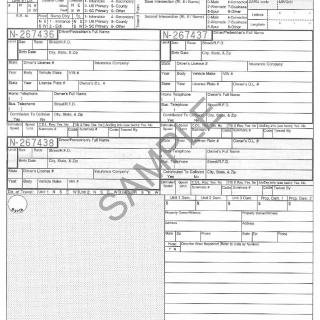SCDMV Form TR-310. Traffic Collision Report Form
The TR-310 Traffic Collision Report Form, issued by the South Carolina Department of Motor Vehicles (SC DMV), is an essential document used to report traffic collisions in the state. It serves as a standardized format for documenting vital information related to the accident and is designed to ensure accuracy and consistency in reporting.
This form consists of several sections that require specific details to be filled out. The main purpose of the TR-310 form is to gather crucial information about the parties involved in the collision, the vehicles, and the circumstances surrounding the accident. It helps law enforcement agencies, insurance companies, and legal representatives assess liability and process claims accurately.
When filling out the TR-310 form, important fields include:
- Personal Information: Details of the individuals involved, such as names, addresses, contact numbers, and driver's license numbers.
- Vehicle Information: Descriptions of the vehicles involved, including make, model, year, registration number, and insurance information.
- Collision Details: Documentation of the date, time, and location of the accident, road conditions, weather, and any contributing factors.
- Narrative Description: A comprehensive account of how the collision occurred, including the sequence of events leading up to it.
- Witness Statements: If available, statements from witnesses who observed the accident.
- Diagram: A diagram illustrating the position and movement of the involved vehicles before, during, and after the collision.
It is important to consider accuracy and completeness when filling out the TR-310 form. Providing incorrect or insufficient information may hinder the investigation process or delay insurance claims. Additionally, it is advisable to attach any relevant supporting documents, such as photographs, police reports, or medical records, which can provide additional evidence or context.
Examples of application and use cases for the TR-310 form include:
- Law Enforcement: Police officers use this form to record details at the scene of an accident and document evidence.
- Insurance Claims: Insured individuals or their representatives complete the form to initiate an insurance claim for damages or injuries sustained in the accident.
- Legal Proceedings: Attorneys may use the TR-310 form as a foundation for building a case involving a traffic collision.
Strengths of the TR-310 form include its standardized format, which ensures consistency and facilitates information sharing between parties involved in the collision. It provides a comprehensive overview of the incident, allowing for accurate assessment and resolution.
Weaknesses may arise from potential human errors or omissions when completing the form. In some cases, individuals involved in the accident may provide conflicting information, leading to challenges in establishing facts.
Opportunities lie in digitalization and automation. The availability of an online version of the TR-310 form could streamline the reporting process, improve data accuracy, and simplify storage and retrieval.
Possible threats associated with the form include the risk of fraudulent claims if inaccurate or misleading information is submitted. Additionally, reliance solely on the TR-310 form may limit the capture of nuanced details or unique circumstances surrounding the collision.
Alternative forms or analogues to the TR-310 form may exist in other states or jurisdictions. These forms may differ in structure, terminology, or required information, but generally serve a similar purpose of documenting traffic collisions.
The future impact of the TR-310 form on participants depends on various factors, such as the effectiveness of data management systems, evolving legal requirements, and advancements in technology. Accurate reporting facilitated by this form can contribute to improved road safety measures, fair claims settlements, and informed policy decisions.
Completed TR-310 forms are typically submitted to the South Carolina Department of Motor Vehicles or other relevant authorities, such as law enforcement agencies or insurance providers. They are stored electronically in databases securely maintained by these entities to ensure accessibility for future reference or investigations.

